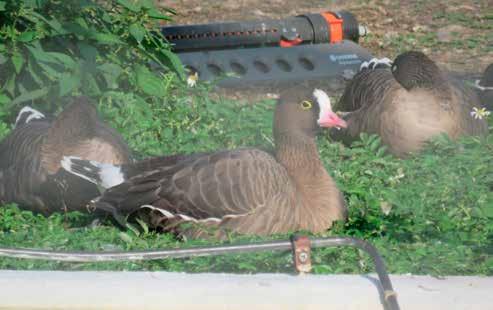
4 minute read
Lesser White-fronted Geese - revisited ............................... Richard Attenborrow
Richard Attenborrow Lesser White-fronted Geese
Lesser White-fronted Geese - revisited
In September, Jean and I went on a wildlife trip to Sweden with Great Glen Wildlife whose leader, David Kent, had worked at the Svenska Jägareförbundet (the Swedish Association for Hunting and Wildlife Management) years ago. Because of this connection, he was able to arrange for us to see the breeding pens and accommodation for the Swedish Lesser White-front project at Öster Malma and to have a talk from Dr Niklas Liljebäck, who is in charge of the project. Much of what Dr Liljebäck told us remains unpublished. This prompted me to write a sort of update to John Grant’s article in the Spring 2015 Harrier, as the four Lesser White-fronts which turned up at North Warren at the end of 2014 were releases from this project. At least one of them, incidentally, is still in the land of the living, breeding in North Sweden and wintering in the Netherlands. Just to remind you, the project was set up in the early 1980s because of an alarming decline in numbers, which was put down to problems on the migration route in Western Asia and Eastern Europe, mostly due to hunting and habitat loss. The radical solution to the problem was to alter the geese’s direction of migration so that they wintered in the relative safety of the Netherlands. This was to be achieved by breeding them in captivity and fostering the young to Barnacle Geese with which they would then migrate to the Low Countries. The Lesser Whitefronts and Barnacles were taken together to Lapland for release onto lakes, the location of which the Lessers would imprint onto and return to after migration, while the Barnacles would return to Öster Malma. As Dr Liljebäck was showing us the geese in their accommodation, whose design is based on many other captive breeding projects visited by him, he told us about the current situation, which is largely optimistic. Last year, 81 were released to the breeding grounds and there have been enough generations migrating in the required direction that they are no longer fostered to Barnacles and are released into appropriate habitat mostly
near Ammarnas. The birds love flying and have long wings. They will fly around for miles almost as soon as released. Niklas’s theory is that, because they are predated by Ravens and Eagles, they have developed manoeuvrability. They try to protect breeding areas by restricting shooting and fishing because of disturbance, but this is not the only problem which has been encountered over the years. A natural hazard was a rogue White-tailed Eagle with a nest just outside the breeding grounds, which specialised in predating Lesser White-fronts, when they were moulting and flightless and therefore vulnerable to predation. A lot of rings and even a transmitter were found on the ground below the nest. This meant that numbers were down, but also that the survivors were agitated and restless and migrating too early. They thought of killing the eagle, but others would probably have moved in, so, in the end they opted for re-location of the geese. Fox predation was countered with electric fences. However there have been political as well as natural inhibitors to success. There is a parallel scheme in Norway, but there is little co-operation between the two. In fact they have produced a report suggesting the Swedish project be abandoned and all efforts concentrated in Norway. There was some talk of stopping Swedish funding, but they have been reassured that it has been so successful that it would be foolish to waste the money already spent on it. Given the arguments against several reintroduction schemes in this country, it will come as no surprise that purists among the conservation community were positing that it is “unnatural” to alter the direction of migration (better to be natural and dead I suppose!). Others were claiming that the captive birds’ young had impure DNA by mixing with Greater White-fronts. The initial releases were of Swedish provenance in which some Greater White-front DNA was detected, but later stock was obtained from Russia, and rigorous testing showed these to be genetically pure. The great thing about all this is that a significant number of geese have had their pattern of migration changed and because of this population levels are rising, which makes for an optimistic story in these gloomy days for conservation. This brings me to another thing we learned in Sweden, which is that hunting and conservation are not mutually exclusive. The Swedish Association for Hunting and Wildlife Management was founded in 1830 and is the oldest and largest conservation body in the country. Their stated aim is to maintain strong game populations by ensuring access to water, food and shelter and reducing predator populations, while at the same time improving the conditions for all wildlife, encouraging less intensive land use, and creating a varied landscape rich in biodiversity. Hunters are controlled in what and when they can shoot and have to know what is in front of them. They enjoy their hunting and everybody else can enjoy the wildlife, which is borne out by the fact that 80% of the Swedish public are supportive of hunting. Compared with what seems to me to be the situation here, where shooting and hunting organisations seem always to be in conflict with conservation bodies (who often seem to be acting independently from each other as well), in Sweden they believe in speaking openly to one another. If you want more detail on the Lesser White-front project, it has its own website (with English translation) on: http:// jagareforbundet.se/en/projektfjallgas/ Our sincere thanks go to Dr Liljebäck, who gave up his time to talk to us so informatively and enthusiastically and David Kent for taking us there in the first place.










